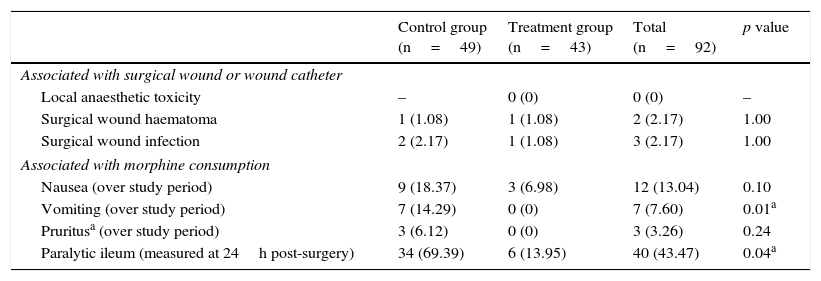For major laparoscopic surgery, as with open surgery, a multimodal analgesia plan can help to control postoperative pain. Placing a wound catheter intraoperatively following colon surgery could optimize the control of acute pain with less consumption of opioids and few adverse effects.
MethodsWe conducted a prospective, randomized, study of patients scheduled to undergo laparoscopic colon surgery for cancer in Galdakao-Usansolo Hospital from January 2012 to January 2013.
Patients were recruited and randomly allocated to wound catheter placement plus standard postoperative analgesia or standard postoperative analgesia alone. A physician from the acute pain management unit monitored all patients for pain at multiple points over the first 48h after surgery. The primary outcome variables were verbal numeric pain scale scores and amount of intravenous morphine used via patient controlled infusion.
Results92 patients were included in the study, 43 had a wound catheter implanted and 49 did not. Statistically significant differences in morphine consumption were observed between groups throughout the course of the treatment period. The mean total morphine consumption at the end of the study was 5.63±5.02mg among wound catheter patients and 21. 86±17.88mg among control patients (p=.0001). Wound catheter patients had lower pain scale scores than control patients throughout the observation period. No adverse effects associated with the wound catheter technique were observed. The wound catheter group showed lower hospital stays with statistically significant difference (p=.02).
ConclusionsIn patients undergoing laparoscopic colon surgery, continuous infusion of local anaesthetics through interfascial wound catheters during the first 48h after surgery reduced the level of perceived pain and also reduced parenteral morphine consumption with no associated adverse effects and lower hospital stays.
Tanto para cirugía laparoscópica como para cirugía abierta la analgesia multimodal puede ayudar a controlar el dolor postoperatorio. La colocación de un catéter en la herida quirúrgica de manera intraoperatoria tras cirugía de colon podría optimizar el control del dolor con menor consumo de opiáceos y menos efectos secundarios.
MétodoRealizamos un estudio prospectivo, aleatorizado de pacientes reclutados para cirugía de colon laparoscópica en el Hospital de Galdakao-Usansolo de enero de 2012 a enero de 2013.
Los pacientes fueron asignados aleatoriamente al grupo del catéter o al grupo de la analgesia postoperatoria estándar. Un miembro de la Unidad de dolor agudo monitorizó todos los pacientes a lo largo de 48h tras la cirugía. Las variables principales analizadas fueron la escala numérica verbal y la cantidad de morfina intravenosa utilizada por cada paciente mediante PCA.
ResultadosSe incluyeron 92 pacientes en el estudio, 43 en el grupo con catéter y 49 en el estándar. Se observaron diferencias estadísticamente significativas en el consumo de morfina entre ambos grupos a lo largo de todo el periodo. La cantidad total de morfina consumida en el grupo del catéter fue de 5,63±5,02mg y de 21,86±17,88mg en el grupo de analgesia estándar (p=0,0001). Los pacientes con catéter presentaban menores valores en la escala numérica verbal. No se encontraron efectos adversos asociados a la colocación del catéter y la administración de anestésico local. El grupo de catéter presentó menor estancia hospitalaria respecto al otro grupo (p=0,02).
ConclusiónEn los pacientes intervenidos de cirugía de colon laparoscópico una infusión continua de anestésico local a través de un catéter interfascial durante 48h tras la cirugía reduce la percepción del dolor y el consumo de morfina intravenosa, disminuyendo la estancia hospitalaria.















